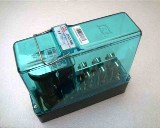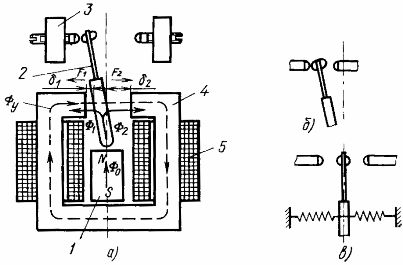Polarized electromagnetic relays
 Polarized electromagnetic relays differ from neutral electromagnetic relays the ability to respond to the polarity of the control signal. The magnetic circuit of a polarized differential relay (Fig. 1, a) has a permanent magnet 1. The polarizing magnetic flux Ф0 passes through the armature 2, branches into two fluxes Ф1 and Ф2 in the air gaps δ1 and δ 2 and closes along the core 4. To increase the speed, the relay is assembled from sheet electrical steel.
Polarized electromagnetic relays differ from neutral electromagnetic relays the ability to respond to the polarity of the control signal. The magnetic circuit of a polarized differential relay (Fig. 1, a) has a permanent magnet 1. The polarizing magnetic flux Ф0 passes through the armature 2, branches into two fluxes Ф1 and Ф2 in the air gaps δ1 and δ 2 and closes along the core 4. To increase the speed, the relay is assembled from sheet electrical steel.
The armature is also assembled from two plates of electrical steel and suspended from a steel spring. The control flux Fu is created by two magnetizing coils 5 located on the core.
The contact system of the 3 relays has one changeover contact. The position of the fixed contacts can be adjusted by changing the relay setting.
If there is no current in the windings, then under the influence of the attraction force created by the flux Ф0, the armature can be in one of the extreme positions, for example, in the left one, as shown in fig. 1, a.
Rice. 1. Polarized electromagnetic relay
The fluxes F1 and F2 are inversely proportional to the size of the air gaps δ 1 and δ 2 between the armature and the corresponding core pole. In the middle neutral position, the fluxes F1 and F2 are the same, and the forces of attraction of the armature to the two poles of the core are equal: F1 = F2. However, this intermediate position of the core is unstable. When moving the armature to the left, the flux F1 increases, and the flux F2 weakens, and there is a corresponding redistribution of the attraction force between the poles: F1> F2.
The action of the control current depends on its polarity. To switch the relay, a current is required, which creates a magnetic flux Fy in the gap, which coincides in direction with the flux F2. Reverse polarity current will increase the flow of F1 and only increase the contact pressure.
For the relay to operate, the flux Fy must exceed the maximum value of the flux F1 at the minimum value of the gap δ.
As the armature moves to the right, the gap δ 1 increases, the flow rate F1 and its opposite influence decrease. In the middle position, dynamic equilibrium occurs, after which the increased flux of F2 creates an additional force that accelerates the armature. This improves the speed of polarized relays. To return the contact system to its original position, it is necessary to reverse the polarity of the current in the control coil again.
A biased relay with this setting is called a two-position relay. It switches under the action of bipolar pulses, and after the termination of the control pulse, the contact system of the relay does not return to its initial state.
In two-position polarized relays with predominance, one of the stationary contacts is extended beyond the neutral line (Fig. 1, b).Such a relay responds to control pulses of a certain polarity only and returns to its original position when the control pulse is removed.
There are three position polarized relays (Fig. 1, c), where the armature is held by springs in the neutral position. Depending on the polarity of the control signal, the left or right contact of the relay closes. When the input signal stops, the armature returns to its original neutral position. This relay is equivalent to two predominantly polarized relays.
Polarized relays are very sensitive. The relay actuation power is 0.01-5.0 mW.
The breaking capacity of the relay contacts is large enough, which makes it possible to switch a current of 0.2-1.0 A at a voltage of 24 V. The amplification factor of polarized relays is (1 — 5) x103.
The high response speed allows the operation of polarized relays with a switching frequency of 100-200 Hz.

